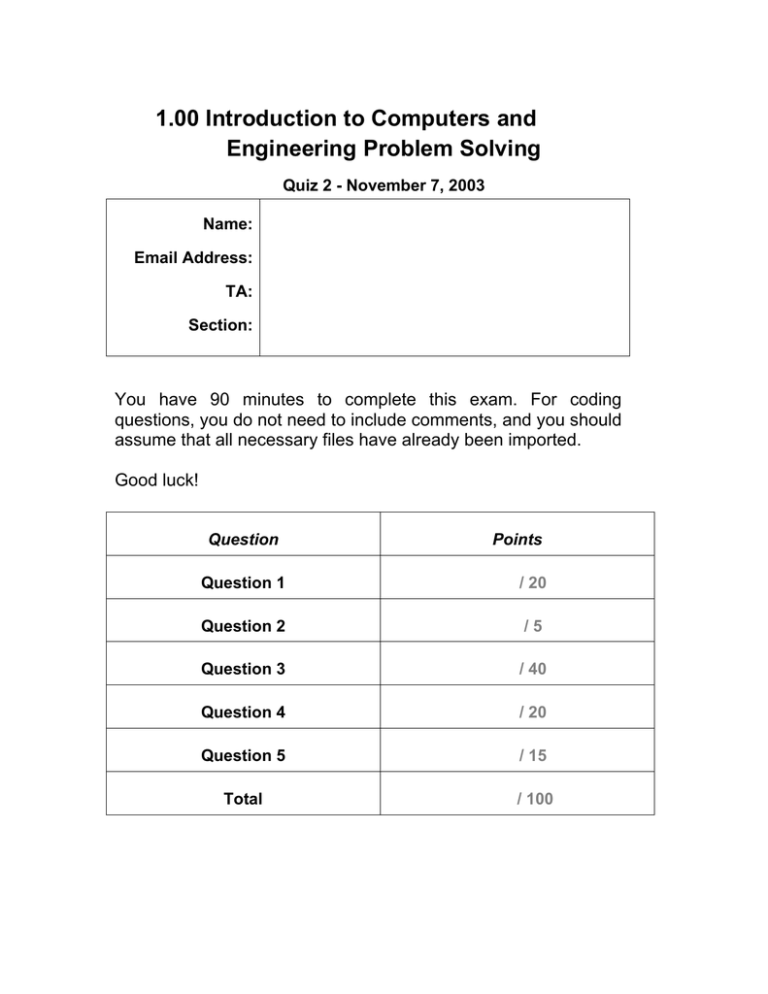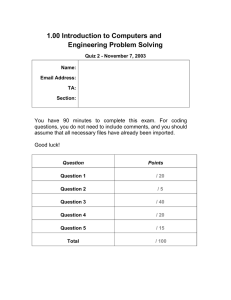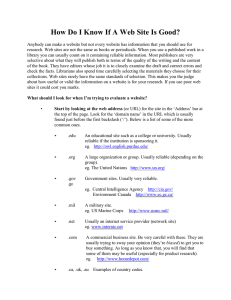1.00 Introduction to Computers and Engineering Problem Solving
advertisement

1.00 Introduction to Computers and
Engineering Problem Solving
Quiz 2 - November 7, 2003
Name:
Email Address:
TA:
Section:
You have 90 minutes to complete this exam. For coding
questions, you do not need to include comments, and you should
assume that all necessary files have already been imported.
Good luck!
Question
Points
Question 1
/ 20
Question 2
/5
Question 3
/ 40
Question 4
/ 20
Question 5
/ 15
Total
/ 100
Question 1. True or False (20 points)
Answer the following questions about Java by circling TRUE or FALSE as appropriate.
1) The value of a reference to an array cannot be changed once the reference is
assigned.
TRUE
FALSE
2) Suppose a function f(x) has a unique root x1. If we use the bisection method with an
initial bracket that does not include x1, we will never converge to the root.
TRUE
FALSE
3) An abstract class can contain concrete methods.
TRUE
FALSE
4) A class inheriting from an abstract class A must override all the methods of A.
TRUE
FALSE
5) If a concrete class Carpet implements an interface IColor, then the statement
IColor c = new Carpet();
is legal.
TRUE
FALSE
6) If a class inherits from another class, it can access all of the base class's data members
and invoke all of the base class's methods.
TRUE
FALSE
7) An interface can have concrete methods.
TRUE
FALSE
8) A class can implement only one interface.
TRUE
FALSE
9) A concrete class that implements an interface doesn’t have to define all the methods in
that interface, but just the ones the class needs.
TRUE
FALSE
10) An interface can extend another interface.
2
TRUE
FALSE
Question 2. (5 points)
What is round-off error?
Please give one example that demonstrates its significance.
Question 3. Numerical Methods (40 points)
Ben Bitdiddle, a Java ace from the BetaGadgets Company, has now become a 1.00 TA.
Wanting to entertain his students during tutorial, he introduces them to fixed-point
iteration and asks them to write a small program to examine its behavior.
To find the roots of a function f(x), fixed-point iteration requires that you rearrange f(x) so
that x is on the left-hand side of the equation. This means, for example, that given an
equation f(x) = x - g(x), the roots of f(x) can be found by performing fixed point iteration
on the equation x = g(x).
In numerical terms, fixed point iteration operates by computing xi+1 = g(xi) , where i and
i+1 are successive iterations. For simplicity, we assume that f(x) is continuous and can
always be rearranged in the way described above.
3
After enlightening his students, Ben asks them to use fixed-point iteration to calculate the
roots of the function f(x) = 1+x-x2 -x3; which means they have to solve the equation x =
x3+x2-1.
Part 1
Ben reminds you that the first step in solving a numerical problem in Java is to write an
interface that will reflect the type of functions you expect to deal with. In the space below,
write an interface IMath that contains a single method g(). This method takes a
double as its sole argument and returns a double.
Answer:
// INSERT YOUR CODE HERE
public interface IMath {
public double g(double x) ;
}
Part 2
Now write a public class MyFunc that implements the interface you have written above.
Remember that we are dealing with g(x) = x3+x2-1, which needs to be “encapsulated”
somehow inside MyFunc.
Answer:
// INSERT YOUR CODE HERE
public class MyFunc implements IMath {
public double g(double x) {
return x*x*x + x*x -1;
}
}
4
Part 3
We now reach the interesting part, which is the actual implementation of the fixed-point
iteration method. You are provided with the following signature for it:
public double fixed (IMath func, double initial, double tol)
The first argument is an object of a class that implements IMath, the second argument is
the initial guess and the third argument is the tolerance. We would like to stop iterating
when the absolute difference between two consecutive estimates of the root becomes
smaller (in absolute value) than the tolerance. Remember that we are iterating using the
equation xi+1 = g(xi), where g(x) is the function given in part 2.
Answer:
public class RootFinder{
public double fixed (IMath func, double initial, double tol){
double prev; //root estimate in previous iteration
double current; //root estimate in current iteration
double diff; //difference between 2 consecutive estimates
// INSERT YOUR CODE HERE
current = initial;
do {
prev = current;
current = func.g(prev);
diff = current - prev;
}
while (Math.abs(diff)>= tol);
return current;
}
}
5
Part 4
The final step is to write a main() method to test your program. You would like to find
a root of f(x) = 1+x-x2 -x3 using fixed-point iteration. Use an initial guess of 0.5 and a
tolerance of 1E-5.
Answer:
public class Driver{
public static void main (String[] args){
double root;
//INSERT YOUR CODE HERE
RootFinder m = new RootFinder();
root = m.fixed(new MyFunc(), 0.5, 1E-5);
System.out.println(root);
}
}
6
Question 4. Swing (20 points)
Below we define a class named Drawing that extends JPanel. Complete the body of
the paintComponent() method so that it draws a rectangle in the center of the
JPanel, whatever the size of the JPanel is.
The class Drawing has a constructor that takes in two arguments which are the length
and width of the rectangle to be drawn in pixels.
Hint: JPanel has methods getWidth() and getHeight().
public class Drawing extends JPanel{
private int length, width;
public Drawing(int l, int w) {
length = l;
width = w;
}
public void paintComponent(Graphics g) {
super.paintComponent(g);
Graphics2D g2 = (Graphics2D)g;
int panelwidth = getWidth();
int panelheight = getHeight();
g2.drawRect((panelwidth-width)/2,
(panelheight-length)/2, width, length);
//using function fillRect instead of drawRect is
//ok too
//drawing four lines that forms a rectangle is ok
//as well
}
}
7
Question 5. URLs, MalformedURLException (15 points)
The class java.net.URL is used to represent a Uniform Resource Locator and points
to a "resource" on the World Wide Web. One of the constructors in this class takes a
single String argument:
public URL(String address)
With this constructor, you could create a URL for MIT's main webpage:
URL mit = new URL("http://web.mit.edu");
However, the documentation also says that this constructor will throw a
MalformedURLException if the String argument isn't a properly formed web
address. For example, because the String argument below isn’t a valid URL, the
following constructor invocation will throw an exception:
URL problem = new URL("O'Doyle RULES!");
Note that the constructor for the URL class has all the logic that determines whether a
given String could represent a valid URL. You don’t have to worry about doing this.
Write code in the main() method below that will:
1. Ask the user to enter a web address using JOptionPane's
showInputDialog() method.
2. Attempt to create a URL object based on their input.
a. If valid, print out "Valid URL: " and the address.
b. If it's not valid, print out "Invalid URL: " and the address.
If someone ran this main() method and entered "http://web.mit.edu" the
output would be "Valid URL: http://web.mit.edu".
If someone ran this method and entered "42" the output would be "Invalid URL:
42".
8
public static void main(String[] args) {
String s = JOptionPane.showInputDialog(null,"Enter URL");
try {
URL u = new URL(s);
System.out.println("Valid URL: " + s);
} catch (MalformedURLException e) {
System.out.println("Invalid URL: " + s);
System.exit(1);
}
System.exit(0);
//
//
//
//
//
You can invoke System.exit() with either
0 or 1: this isn't important. However, invoking
showMessageDialog started the AWT Event Thread
and the program will hang without an explicit
System.exit().
}
9



